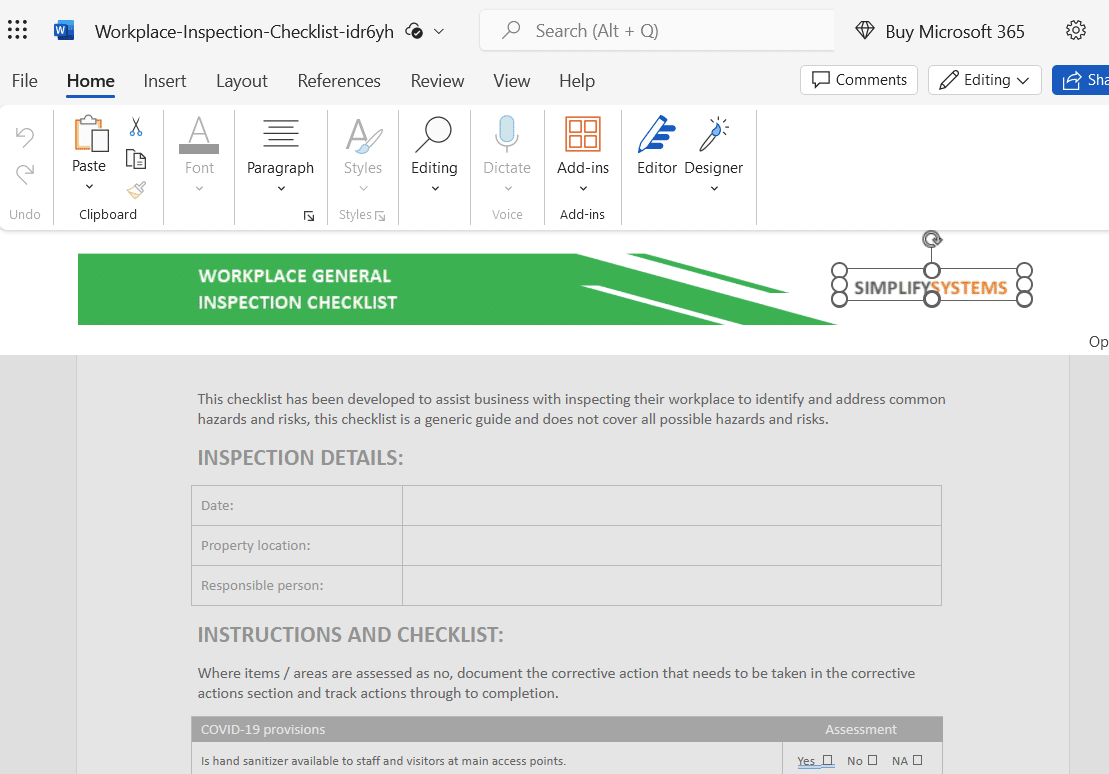SimplifySystems
Guide to Personalising our Templates

Guide to Personalising a Template in Microsoft Word

Personalisation Steps:
- Replace the Simplify Systems Logo:
- Cover Page: To begin personalising your document in Microsoft Word, open the template file. First, remove the Simplify Systems logo from the cover page by clicking on the image and pressing the Delete key. Now, insert your business name or logo by going to the ‘Insert’ tab, selecting ‘Picture,’ and choosing your logo or typing your business name.
- Headers: Similarly, remove the Simplify Systems logo from the headers within the document. Click on the logo, press Delete, and replace it with your own logo or business name.
- Insert Your Business Name:
- Throughout the document, you’ll find placeholders such as “[insert organization].” Use Microsoft Word’s ‘Find and Replace’ function to efficiently replace these placeholders with your business name. Here’s how:
- Press
Ctrl + H(or go to ‘Replace’ under the ‘Home’ tab). - In the ‘Find what’ field, enter “[insert organization].”
- In the ‘Replace with’ field, type your business name.
- Click ‘Replace All’ to replace all instances at once or ‘Replace’ to change them one by one.
- Press
- Throughout the document, you’ll find placeholders such as “[insert organization].” Use Microsoft Word’s ‘Find and Replace’ function to efficiently replace these placeholders with your business name. Here’s how:
- Review and Customise Content:
- Thoroughly review the entire document. Edit and customise sections as needed to align them with your specific business needs and processes. To edit text, simply click within the text box and start typing.
- Remove Irrelevant Sections:
- If you come across sections that are irrelevant to your business or operations, delete them from the document. To remove a section:
- Highlight the text or section you want to delete.
- Press the Delete key or right-click and select ‘Cut.’
- If you come across sections that are irrelevant to your business or operations, delete them from the document. To remove a section:
- Update Heading Numbering and Contents Page:
- If you add, remove, or modify content within the document, make sure to review and update the heading numbering to maintain the correct sequence. Also, update the table of contents to reflect any changes. Here’s how:
- To update heading numbering, right-click the heading and select ‘Bullets & Numbering.’
- To update the table of contents, right-click it and select ‘Update Field’ or ‘Update Table.’
- If you add, remove, or modify content within the document, make sure to review and update the heading numbering to maintain the correct sequence. Also, update the table of contents to reflect any changes. Here’s how:
- Commence Implementation and Training:
- After personalizing the document to align with your business, it’s time to commence implementation in consultation with your workers. This can involve communication, training, and working directly with your team to ensure they understand and follow the document’s guidelines.
- Contact for Assistance:
- If you require further assistance or need additional content to support the document, you can contact Simplify Systems at info@simplifysystems.com.au or call 0417 895 213.
With these steps, you’ll be able to efficiently personalize your document in Microsoft Word to make it uniquely tailored to your business needs.
Guide to Personalising a Template in Google Docs

Personalisation Steps:
- Replace the Simplify Systems Logo:
- Cover Page: To begin personalising your document in Google Docs, open the template file. First, remove the Simplify Systems logo from the cover page by clicking on the image and pressing the Delete key. Now, insert your business name or logo by going to ‘Insert’ in the top menu, selecting ‘Image,’ and choosing your logo or typing your business name.
- Headers: Similarly, remove the Simplify Systems logo from the headers within the document. Click on the logo, press Delete, and replace it with your own logo or business name using the ‘Insert’ > ‘Image’ option.
- Insert Your Business Name:
- Throughout the document, you’ll find placeholders such as “[insert organization].” To efficiently replace these placeholders with your business name, follow these steps:
- Click ‘Edit’ in the top menu.
- Choose ‘Find and Replace.’
- In the ‘Find’ field, enter “[insert organization].”
- In the ‘Replace with’ field, type your business name.
- Click ‘Replace’ to change them one by one or ‘Replace all’ to replace all instances at once.
- Throughout the document, you’ll find placeholders such as “[insert organization].” To efficiently replace these placeholders with your business name, follow these steps:
- Review and Customize Content:
- Thoroughly review the entire document. Edit and customise sections as needed to align them with your specific business needs and processes. To edit text, simply click within the text box and start typing.
- Remove Irrelevant Sections:
- If you come across sections that are irrelevant to your business or operations, delete them from the document. To remove a section:
- Highlight the text or section you want to delete.
- Press the Delete key.
- If you come across sections that are irrelevant to your business or operations, delete them from the document. To remove a section:
- Update Heading Numbering and Table of Contents:
- If you add, remove, or modify content within the document, make sure to review and update the heading numbering to maintain the correct sequence. Also, update the table of contents to reflect any changes. Here’s how:
- To update heading numbering, select the heading, right-click, and choose ‘Bulleted list’ or ‘Numbered list.’
- To update the table of contents, click on it, then select ‘Update table of contents’ from the menu that appears.
- If you add, remove, or modify content within the document, make sure to review and update the heading numbering to maintain the correct sequence. Also, update the table of contents to reflect any changes. Here’s how:
- Commence Implementation and Training:
- After personalizing the document to align with your business, it’s time to commence implementation in consultation with your workers. This can involve communication, training, and working directly with your team to ensure they understand and follow the document’s guidelines.
- Contact for Assistance:
- If you require further assistance or need additional content to support the document, you can contact Simplify Systems at info@simplifysystems.com.au or call 0417 895 213.
With these steps, you’ll be able to efficiently personalise your document in Google Docs to make it uniquely tailored to your business needs.

Ryan Kellen, with over 15 years of experience in risk, safety, and operations across diverse industries, is a recognized specialist in risk management, systems, people risk, public safety, and health and safety. He has held key positions, including Head of Risk & Safety for Formula 1 and Motorcycle Grand Prix events, making him adept at developing and implementing vital strategies and systems for sustainable outcomes. Ryan holds formal qualifications in risk management, occupational health and safety, emergency and disaster management, international relations, change management, building and construction, and training and assessment. Connect on LinkedIn
Subscribe to our mailing list
Want to find out when we release new risk and safety systems, standards and templates?
New products
Special offers
Updates to existing products
Free templates and much more...
We hate spam just as much as you do. By signing up for our mailing list, you'll only receive valuable information and updates that are relevant to you. We promise to keep your information safe and secure, and you can unsubscribe at any time.